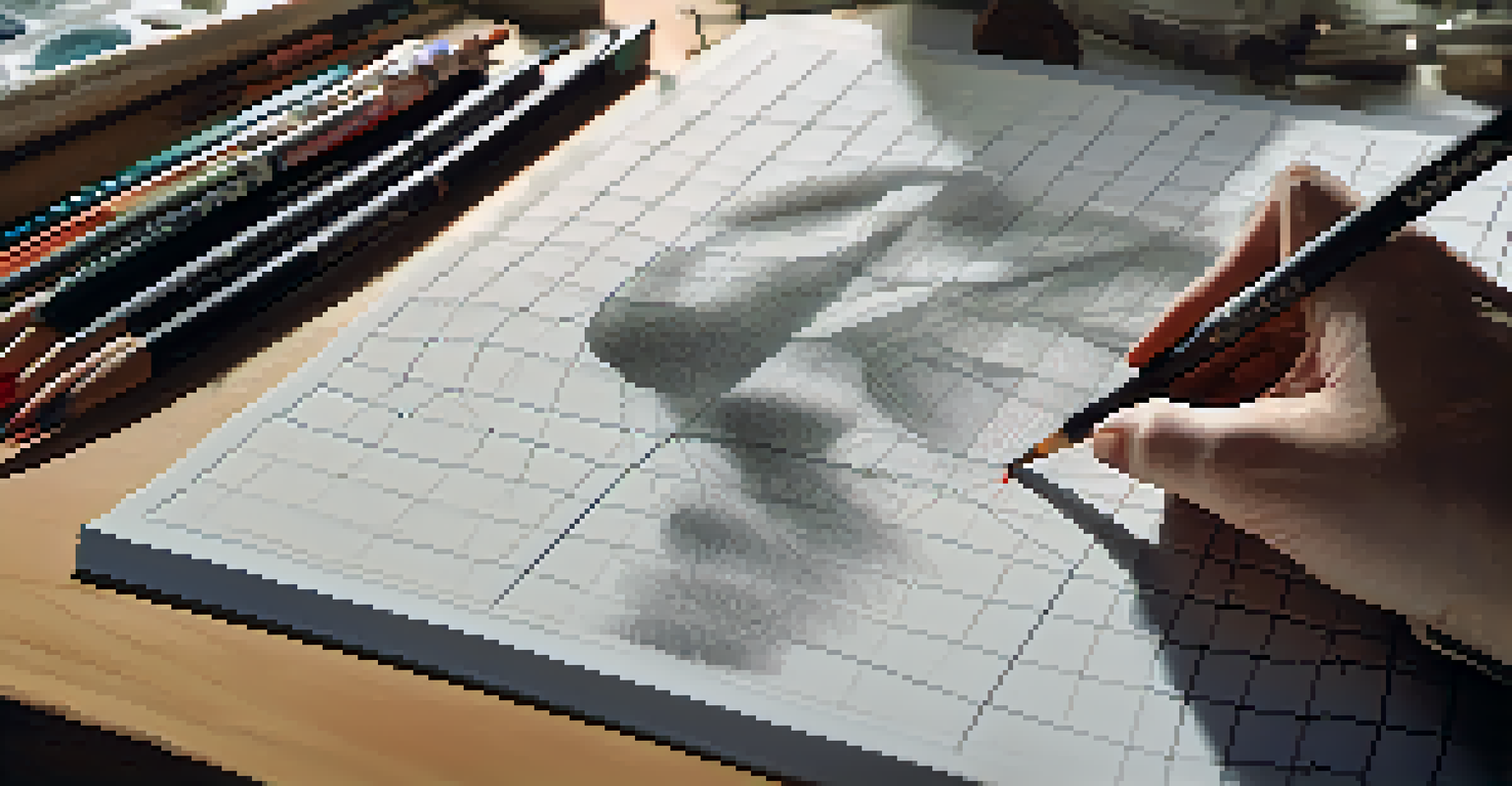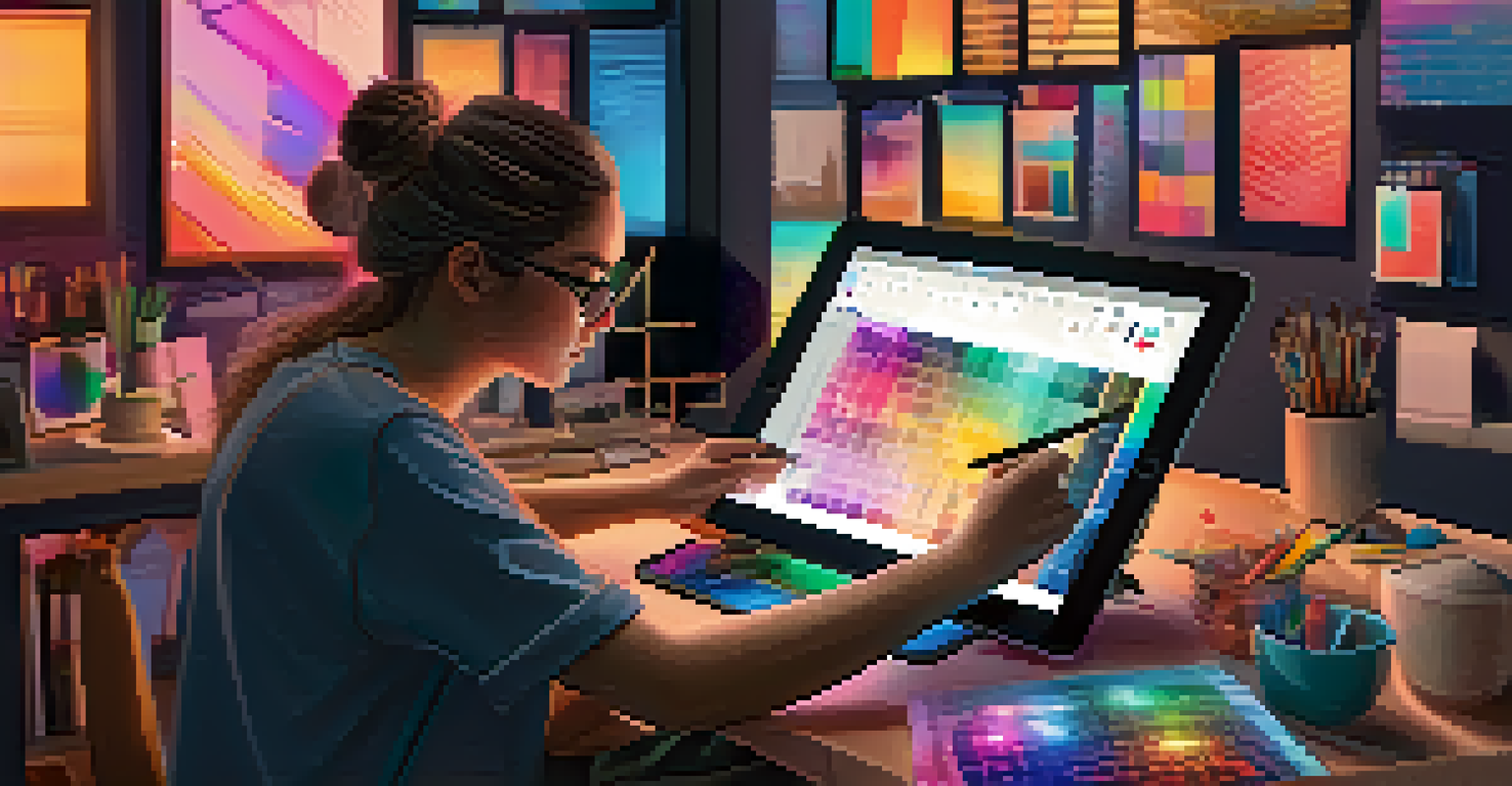Using Grids for Accurate Proportions in Drawing and Painting

Understanding the Purpose of Using Grids in Art
Grids are a powerful tool for artists, helping to maintain accurate proportions in their work. By dividing a reference image into smaller sections, grids allow you to focus on one area at a time, making it easier to replicate complex shapes and details. This method is especially useful for beginners who may struggle with scale and perspective.
The more you practice, the better you get, the more natural it becomes.
Imagine trying to piece together a puzzle without a reference image; it would be challenging to see how the pieces fit together. Similarly, grids guide you, creating a structured approach that enhances your confidence. They can transform a daunting canvas into a manageable task, allowing artists to work methodically.
Additionally, using grids can help improve your observational skills. As you learn to compare your drawing against the reference image, you start to notice subtleties in proportions, angles, and relationships between different elements. Over time, this practice can lead to a more intuitive understanding of form.
Choosing the Right Grid Method for Your Project
There are several methods for creating grids, each offering unique advantages. The most common approach involves drawing a grid over your reference image and a corresponding grid on your drawing surface. This traditional method is effective for both drawing and painting, allowing you to transfer details accurately.

Another popular method is using a digital grid, which can be easily adjusted and manipulated. Many art applications allow you to overlay a grid on your images, making it simple to scale and rotate as needed. This flexibility is particularly beneficial for artists working on digital platforms or mixed media projects.
Grids Enhance Artistic Accuracy
Using grids helps artists maintain accurate proportions and improves observational skills.
No matter which method you choose, it’s essential to consider the size of your grid. Smaller grids can provide more detail but may be overwhelming for larger compositions. Conversely, larger grids simplify the process but can lead to a loss of intricate details. Finding the right balance is key to achieving the desired outcome.
Creating Your Grid: Step-by-Step Instructions
To create a grid, start by deciding on the size of your final artwork and the number of squares you want. For instance, if you're working on an 18x24 inch canvas, you might choose a 3x4 grid, resulting in 6-inch squares. This makes it manageable to focus on one section at a time while still capturing the overall image accurately.
Art is not freedom from discipline, but disciplined freedom.
Next, draw a light grid over your reference image using a ruler and pencil. You can use any grid size that suits your needs, but consistency is crucial. Then, replicate the same grid on your drawing surface, ensuring that the squares match in size and alignment. This step is vital for maintaining proportional accuracy.
Finally, begin transferring the details from one square at a time. Focus on replicating what you see within each grid section, rather than getting overwhelmed by the entire image at once. This method not only improves precision but also enhances your overall workflow.
Tips for Maintaining Accuracy with Grids
Accuracy is key when using grids, and there are several tips to help you achieve the best results. First, use a light touch when drawing your grid lines, as they will need to be erased later. This will ensure they don’t interfere with your artwork's final look. You can use a graphite pencil or even a light-colored chalk pencil for easy removal.
Second, step back frequently to view your work from a distance. This perspective can help you identify any inaccuracies that might not be noticeable up close. It’s easy to get lost in the details, but a broader view can reveal how the overall composition is coming together.
Choose the Right Grid Method
Selecting an appropriate grid method, whether traditional or digital, can significantly impact your artwork's outcome.
Lastly, don’t be afraid to adjust as you go. If you notice that something doesn’t seem right, trust your instincts. You can always make corrections, whether it’s adjusting the grid or altering the proportions of your drawing. Flexibility is essential in the creative process.
Common Challenges When Using Grids
While grids are incredibly helpful, they also come with challenges. One common issue is becoming overly reliant on the grid, which can stifle creativity. It's important to remember that grids are a tool, not a crutch. Once you feel comfortable with your skills, try stepping away from the grid to allow for more spontaneous expression.
Another challenge is the temptation to rush through the grid process. It might seem tedious, but taking the time to set up your grid correctly will pay off in the long run. Rushing can lead to mistakes that may be difficult to correct later, so patience is key.
Lastly, ensuring that your grid is accurately aligned with your reference image can be tricky, especially for larger artworks. Double-check your measurements and angles to minimize errors. This attention to detail will help you avoid frustration as you progress with your artwork.
Exploring Various Applications of Grids in Art
Grids aren't just limited to drawing and painting; they can also be applied in various art forms. For instance, photographers often use grids to help compose their shots, ensuring that elements are balanced within the frame. This technique can be particularly useful for landscape and portrait photography.
Moreover, in digital art, grids can aid in creating pixel art or designing intricate patterns. Many digital artists rely on grids to maintain consistency and precision, especially when working on larger projects that require attention to detail.
Grids in Various Art Forms
Grids are versatile tools not only for drawing and painting but also for photography, digital art, and sculpting.
Even in sculpting, artists can use a grid to create accurate maquettes. By scaling down a design and using a grid, sculptors can ensure that their final pieces are proportionate and true to their original vision.
Final Thoughts on Using Grids in Your Artistic Practice
Incorporating grids into your artistic practice can significantly enhance your ability to create accurate and proportionate works. They serve as a guiding framework that can simplify complex compositions, making art more accessible for artists of all skill levels. Embracing this technique may just be the key to unlocking your full creative potential.
As you become more comfortable with grids, remember to blend them with your personal style. Use them as a foundation to build upon, allowing your unique voice to shine through your work. This balance between structure and creativity can lead to stunning results.

Ultimately, grids are a versatile tool that can evolve alongside your artistic journey. Whether you’re a beginner looking for guidance or an experienced artist seeking precision, grids can elevate your work and help you achieve the proportions you desire.